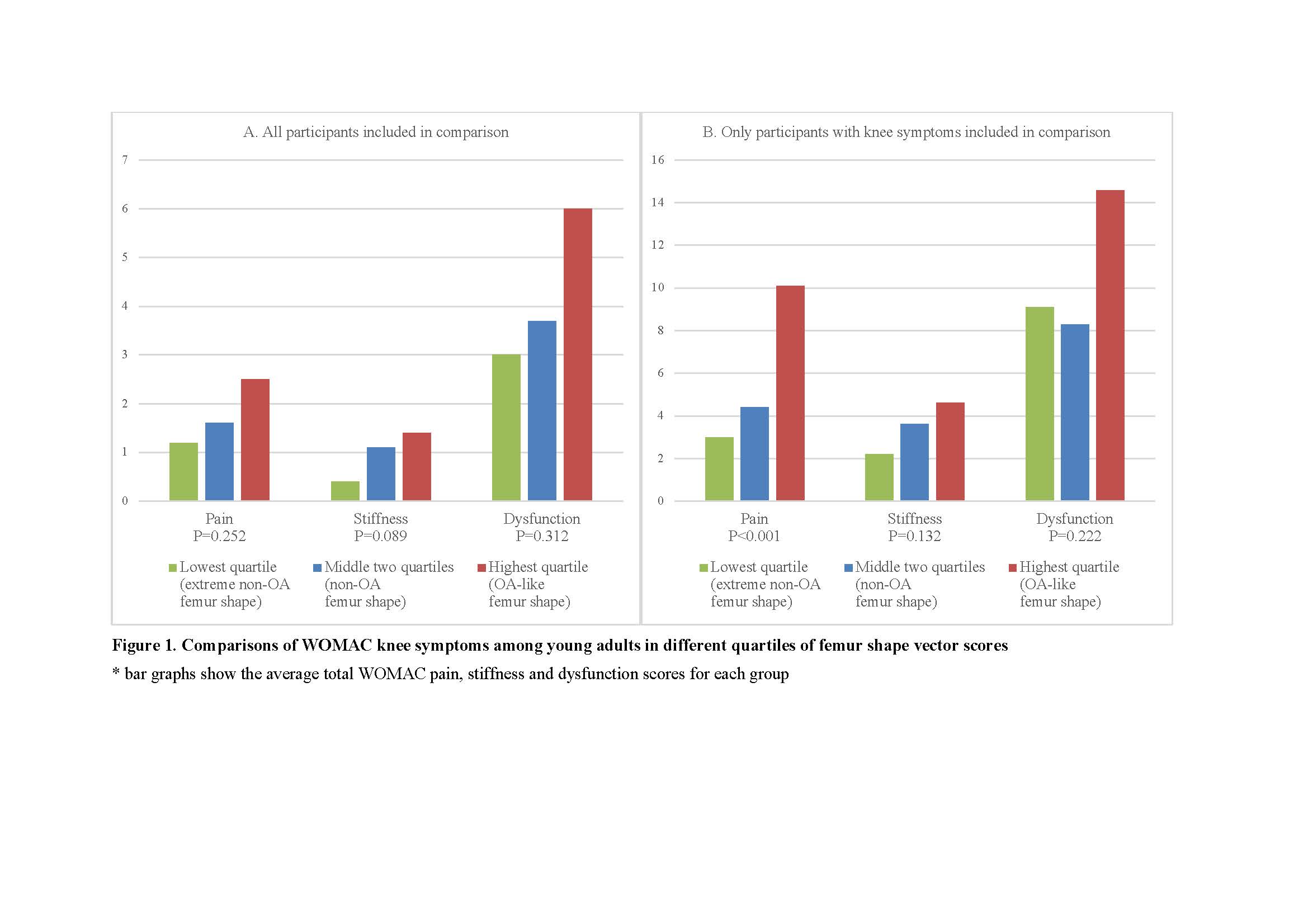Session Information
Session Type: Poster Session (Monday)
Session Time: 9:00AM-11:00AM
Background/Purpose: The femur bone shape derived from magnetic resonance imaging (MRI) of the knee is associated with the incidence and progression of knee osteoarthritis (OA), and predicts total knee replacement in older adults. However, the clinical significance of the femur bone shape has not been studied in a population-based young adult sample. This study aims to describe whether three-dimensional (3D) femur bone shape derived from knee MRI is associated with knee symptoms in young adults.
Methods: Participants (n = 180, age 31 to 41 years) were selected from the Childhood Determinants of Adult Health (CDAH) Knee Cartilage Study, which was a follow-up of the CDAH study. Participants’ knee symptoms were assessed using the Western Ontario and McMaster Universities Osteoarthritis Index (WOMAC) questionnaires, and participants underwent a 1.5T MRI scan of their knee. T1-weighted, fat suppressed, 3D SPGR MRI sequences were segmented with an active appearance model (AAM) previously constructed and validated in an Osteoarthritis Initiative study. The femur bone shape found by AAM is projected orthogonally onto a femur shape vector to obtain a vector score. The femur shape vector defined 0 as the average healthy femur shape and higher values in the positive direction portray more likeness to OA with each unit representing one standard deviation. Logistic regressions were used to describe the associations between the highest quartile of femur shape vectors (OA-like shape) with demographic factors and WOMAC knee symptoms.
Results: Participants had a mean age of 35.5±2.8 years, mean BMI of 25.1±4.1 kg/m2, were 51% male and largely asymptomatic (34% with any knee pain). The highest quartile of femur vector scores–the group considered to have an OA-like femur shape–had vector scores higher than +0.40. OA-like femur shape was not associated with age (OR 0.96, 95% CI 0.85 to 1.09), gender (OR 1.93, 95% CI 0.95 to 3.93), or body-mass index (OR 1.05, 95% CI 0.97 to 1.14). There was no association between OA-like femur shape and total WOMAC pain (OR 1.06, 95% CI 0.97 to 1.15), total WOMAC stiffness (OR 1.08, 95% CI 0.93 to 1.25) and total WOMAC dysfunction (OR 1.02, 95% CI 0.98 to 1.06) (Figure 1A). However, in symptomatic young adults, OA-like femur shape was associated with higher knee pain scores (OR 1.33, 95% CI 1.07 to 1.66) (Figure 1B).
Conclusion: OA-like femur bone shape is not associated with knee symptoms in population-based young adults. However, OA-like femur bone shape is associated with higher pain scores in young adults experiencing any knee pain.
To cite this abstract in AMA style:
Vo M, Bowes M, Venn A, Cicuttini F, March L, Dwyer T, Meng T, Cross M, Jones G, Balogun S, Ding C, Antony B. Clinical Significance of Magnetic Resonance Imaging Derived Femur Bone Shape in Young Adults [abstract]. Arthritis Rheumatol. 2019; 71 (suppl 10). https://acrabstracts.org/abstract/clinical-significance-of-magnetic-resonance-imaging-derived-femur-bone-shape-in-young-adults/. Accessed .« Back to 2019 ACR/ARP Annual Meeting
ACR Meeting Abstracts - https://acrabstracts.org/abstract/clinical-significance-of-magnetic-resonance-imaging-derived-femur-bone-shape-in-young-adults/

